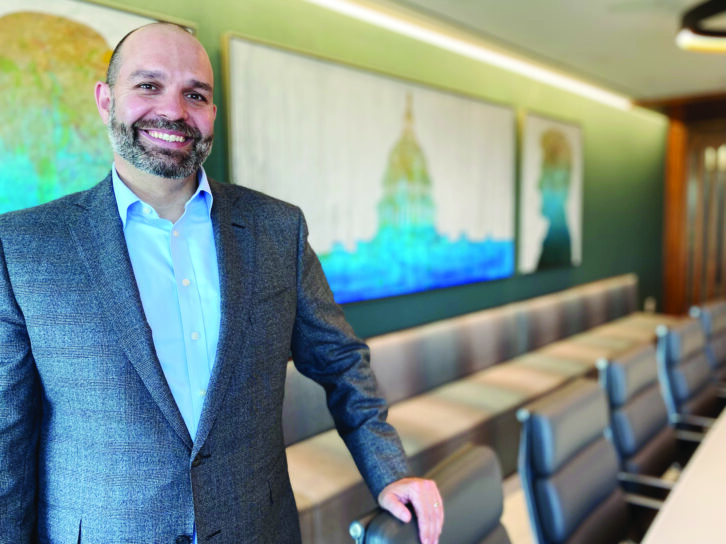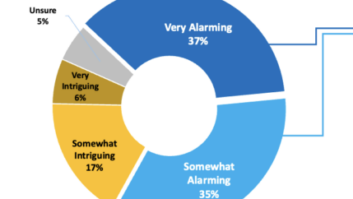NAB President/CEO Curtis LeGeyt has spent the 12 months since the last NAB Show navigating policy matters, such as the sense of crisis for AM radio in cars and the potential impact of generative AI on broadcast media.
He is assessing the implications of this year’s election cycle and preparing to defend the broadcast industry from the threat of additional music royalty costs. He also is preparing for a court challenge to the FCC’s refusal to ease ownership subcaps.
Radio World Editor in Chief Paul McLane and contributor Randy Stine interviewed him.
Radio World: What do you see as the key policy issue for radio right now?
Curtis LeGeyt: Preserving AM radio’s place in the automobile. Over the last year, I have been absolutely overwhelmed by the engagement from AM radio listeners across the country reaching out to their lawmakers to ensure they’re aware of the importance of AM radio in the automobile. More than 400,000 listeners have reached out to their members of Congress to tell them how important AM radio is. As a result legislation has been introduced in both the Senate and the House, purely bipartisan.
Between the two bodies, more than 240 senators and members of Congress are co-sponsors of the AM Radio for Every Vehicle Act. And they span the political spectrum from Bernie Sanders to Ted Cruz. We feel we are very, very well positioned on this legislation. But the hard work is in front of us, ensuring that we can get it to a bill that ultimately is taken up on the floor of both chambers.

RW: Has there been communication directly between NAB and car companies?
LeGeyt: We have had ongoing conversations with individual automakers but most significantly with our counterpart trade organizations, reaffirming the importance of this issue, not just for broadcasters but for consumers.
You’ve got 82 million listeners every month who continue to tune into the AM dial. While it is easy to be focused on the bright, shiny object of streaming services and ensuring that you’ve got a full range of entertainment options in the automobile, the ongoing relevance of AM radio makes it a must-have in the auto — for consumer appeal but also as a matter of public safety. We have had our doors open for continued conversations with the automakers.
RW: How do you reply to senators who have said it’s not the government’s place to do this?
LeGeyt: The federal government has a long history of imposing public safety requirements on the automobile, from seatbelts to airbags. This is such a matter of public safety, especially given AM’s role as an entry point for the emergency alerting system. This is exactly the place where Congress has acted and should act when it comes to enabling public safety in the automobile.
[Read more stories about the future of AM radio in cars]
RW: The FCC seems ready to give geo-targeting a green light. The chairwoman has put forward a proposal, and at least two other commissioners favor the idea. If the vote is yes and they say go ahead with this three minutes an hour, what’s the outcome?
LeGeyt: Over the course of the last two years, I have talked to radio broadcasters, my members of all sizes and all different market types. I don’t feel there is an overwhelming interest in this technology, and we have conveyed as much to the FCC.
We certainly appreciate the fact that the FCC slowed down this proceeding to look at the technical issues and understand the impact of this technology on radio.
The order that they have on circulation is only an interim step, and there’s going to be a further notice, more process. But I don’t think there is much interest in this technology as judged by the reaction of my membership.
Further, what we have said to the commission, and what I would remind our membership, is that our competitive advantage is in the range of our signal. A technology that would undermine our ability to reach the masses cuts radio off at the knees.
RW: It doesn’t sound like you accept the argument proponents have put forward that geo-targeting would benefit minority and smaller broadcasters in particular.
LeGeyt: It just doesn’t match what I have heard from my members whose businesses are focused on serving minority audiences.
RW: You’ve protested about the FCC dragging its feet on its quadrennial review of ownership rules, and they finally did finish the 2018 under a court order. But they declined to ease the radio sub-caps. Is there any reason to think that the FCC under a Democratic administration is going to change those?
LeGeyt: This is why the courts are so important, now that the FCC 2018 order was just published in the Federal Register [in February]. We feel that the record is overwhelming in support of modernizing these ownership restrictions, especially as it relates to the sub-caps.
We believe that, Democrat or Republican, there is overwhelming concern for the state of local broadcast in this country and for our ability to compete in an environment that has been completely upended by the large tech platforms. So we are looking forward to making our case in court as to why the FCC may need clarity in how these facts ought to be applied to the current law. The record speaks for itself that media ownership modernization is long past due.
RW: That means you’re going to appeal this 2018 ruling?
LeGeyt: We are continuing to examine all of our legal options, but I absolutely expect to appeal this ruling.
RW: The comments filed by various broadcast groups show that there is not unanimity about the sub-caps. iHeart’s filings and yours have not been in total sync. Aren’t there reasonable arguments that it might not be good for local radio to change those sub-caps on the FM dial?
LeGeyt: NAB represents a broad tent of broadcasters. But an overwhelming number of our members are in strong support of modernizing these media ownership rules. That’s why NAB has taken the position that we have. And we think the record is clear that elimination of these sub-caps is long past due.
RW: Update us on your efforts to fend off the annual proposals in Washington like the American Music Fairness Act that would require broadcasters to pay royalties to performers.
LeGeyt: We continue to be pleased with the degree of congressional opposition to any new performance fee on local radio stations. In this Congress again, more than 200 members of the House of Representatives have co-sponsored our local Radio Freedom Act, which opposes any new performance royalty — another two dozen in the Senate are co-sponsors of that resolution.
We’ve made clear to the recording industry as well as to the supporters of the American Music Fairness Act that our door is open for conversations around this issue, especially if there is a solution that will better enable broadcasters to economically compete as audiences are moving over to streaming, but we are adamantly opposed to a standalone terrestrial performance fee. As is a critical mass of members of Congress.
RW: You’ve spoken on the Hill about the possibilities and threats of artificial intelligence. Specifically for radio, what do you think would be the best outcome of AI and generative AI technology?
LeGeyt: Every radio station in the country is making very hard choices right now as to how to best deploy their human capital to serve their communities. And that means trusted local voices who are boots on the ground in the community. That can be news, it can mean events that bring communities together, or it can mean localized entertainment that can only be done by humans.
To the degree that we can utilize generative AI technologies to take some of the burdens off administrative tasks at a station — scriptwriting or having a presence during those dayparts where it might not otherwise be economically viable to have a live voice — I think there’s real opportunities there.
But I view it through the lens of how AI best enables us to deploy the people in our stations, for those areas of community service that only they can do. There’s opportunity; but we need to proceed with absolute caution, because if we are not competing and excelling in the area local radio does best, that community commitment, we’re just another audio medium.
[Read More Radio World Stories About Artificial Intelligence]
RW: The NAB has put out very good resources on issues like best practices to support how radio looks in car dashboards. Is there a place for best practices for AI and radio from the NAB?
LeGeyt: There is. We’re working closely with our members to best focus our resources and how we can be most helpful to our membership. You’re going to see a lot of programming focused on those issues at the NAB Show in April, and dozens of programs around generative AI — use cases, the policy concerns around licensing and attribution as well as protection of your trusted local personalities. But I think this is exactly where NAB needs to lead.
RW: We asked about the best outcome; what’s the biggest risk? Would it be to the intellectual property and unique voices of broadcasters, with people copying and abusing them?
LeGeyt: The biggest risk is that this technology uses our content as well as our formats to train models that will ultimately compete with us. And they will do it without compensating us for it.
It’s the story that we are telling in Congress every day. We’re all for innovation, but we have to ensure that it doesn’t happen at the expense of local broadcasting.
RW: Can you identify the challenges of dealing with a congressional body that some people describe as chaotic and can’t get big stuff done?
LeGeyt: I think that in spite of the hyperpolarized environment we’re operating in, NAB has been very successful in getting our message across. I’m confident we are going to have a seat at the table and be in those conversations on what these chambers can actually get enacted into law.
As you know, Washington tends to do a lot of things all at once. We’re confident that we’re going to be well positioned when those moments happen.
No doubt the inability of Washington to deal with larger legislative issues outside the purview of broadcasters, whether it relates to appropriations or foreign policy, is jamming everything up in a way that does impact even our smaller issues on a relative scale.
RW: If you had to identify one, what would you consider your most important radio success since you’ve taken the NAB leadership role?
LeGeyt: I think it’s the tremendous traction that we’ve gotten the AM Radio For Every Vehicle Act. In such short order, to have identified the threat and to have mobilized broadcast stations all across the country, all markets, all ownership groups, and their listeners to engage with Washington, and to have such a strong bipartisan bill that has already passed the Senate Commerce Committee — we’re very proud of that.
RW: You’ve also had something of a win with broadcast fees with the FCC. Was that a substantial savings for members?
LeGeyt: We’re very pleased with the FCC’s willingness to accept the arguments that we’ve been making over several years and make a modification to their regulatory fee methodology, especially for our midsize and smaller stations. That savings of $7 million really goes to the bottom line, industry wide.
RW: Are there other policy issues to mention?
LeGeyt: I do want to revisit one, which is how the constraints on ownership are really problematic for the viability of radio. We are absolutely going to continue to be on offense, taking our case to the court, ensuring that members of Congress hear this story.
We have strong bipartisan support at the Capitol from those who believe in the value of their local radio station and want to see us thrive. They understand the impact that large tech companies have had on the advertising marketplace. We’re competing with one arm tied behind our backs, so there’s a real sense of urgency there. I hear it from my members of all sizes, and that’s a tremendous focus for NAB.
RW: We do hear an awful lot from small- and medium-market broadcasters who are desperate to find good people to hire, specifically in engineering. Is there more the association can be doing?
LeGeyt: We’ve just launched a set of new initiatives around industry recruitment. There’s now a more robust and modernized industry-wide database for job postings that serves as a destination for job seekers, as well as a set of assets including advertising radio advertisements, and digital tools for stations to customize and use in their recruitment efforts.
This can be used whether you’re talking about talent behind the microphone, production side, sales, engineering. It will help our stations who are dealing with all kinds of competitive pressures and give them some tools to boost their recruitment.
RW: Assess the outlook for major trade shows now after COVID era. What does recent attendance at IBC and CES foretell for NAB?
LeGeyt: I expect we are going to see another significant attendance boost this year. I’m very bullish on where this trade show is. If you put out a high-quality, in-person experience, for an attendance base who can’t get it anywhere else, it will succeed.
Our exhibitor square footage is going to outpace what we had last year. Exhibitors are looking for opportunities to get in front of their customers.
The NAB Show has expanded its bandwidth far outside the core broadcast audience, to a much broader set of content creators and distributors. There’s so much changing about this business that you can’t keep up if you’re trying to do it virtually. We are a central stop for anyone in content creation and at any stage of the distribution chain.
RW: Karen Chupka is in place now as head of NAB’s conventions arm to succeed Chris Brown, who will step down after the show.
LeGeyt: We brought in Karen to write this next chapter for us. She is a person with a long history of building new initiatives that appeal to new segments of a marketplace. I’m confident our show assets will grow. Karen is going to carry on Chris’s legacy of building a tremendous platform for those tech companies that exhibit to the media audience.
The future for the NAB Show is content creation, distribution and monetization, and in a range of industries far outside of traditional radio and television. This show needs to capture that from a B2B perspective. There’s a tremendous demand for it.












